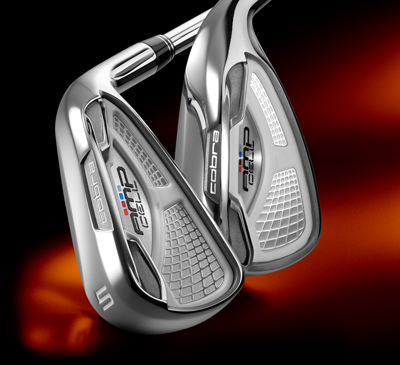AMP Cell irons
Golf Monthly Senior Staff Writer Paul O'Hagan tests the new Coba AMP Cell irons

PGA pro verdict: These irons felt great on impact. They gave the impression of fast ball speeds, which was aided by the lightweight steel shafts. The grips had a soft, comfortable feel, which really impressed, while the impressive flight on offer was easy to control. A certain winner that will suit a wide range of handicaps. By Top 25 Coach John Jacobs Test team rating: Performance: 4/5 Visual appeal: 4.5/5 Innovation: 3.5/5 Value: 4/5 Overall: 4/5
Why you can trust Golf Monthly
Aesthetics:
1) Address view: the midsize head will appeal to many. The distracting orange bottom groove of the previous set has gone, and the head looks better for it.
2) Shelf appeal: Although the standard option silver badge design is more subtle than before, it still catches the eye in the bag. As a custom option, you can match the colour of the cavity to the AMP Cell woods.
Components:
3) Stock shafts: True Temper's Dynalite 90 is the standard steel shaft, while the graphite option is the Cobra MRC AMP Cell shaft (which adds £100 to the set). The steel option tested produced a high flight throughout the set, which was particularly noticeable in the longer clubs.
4) Grip Lamkin's REL .600 offering provides impressive levels of grip without being harsh on the hands.
Technology:
Subscribe to the Golf Monthly newsletter to stay up to date with all the latest tour news, equipment news, reviews, head-to-heads and buyer’s guides from our team of experienced experts.
5) Construction: the head design is inspired by driver and fairway wood technology. In the 4 to 7 irons a thin, but strong, steel face is welded to a softer stainless steel body. This combination generates faster ball speeds across the face to increase distance.
6) Weighting: in order to position the centre of gravity directly behind the sweet spot, weight has been moved from the face and body of the head to the perimeter. This helps to increase the forgiveness on offer.
Performance:
7) Feel: although the feel is unspectacular, it is very solid. The ‘click' at impact is similar from any part of the face, and will inspire confidence rather than offering a huge amount of feedback. The feel is very similar to the previous version, but now provides improved forgiveness.
8) Flight: this shaft and head combination produces a very high flight, which is particularly impressive given the strong lofts of the clubs. Combined with the forgiveness on offer, they'll suit anyone after easy-to-hit irons that aren't oversized.
9) Distance control: the strong lofts, lightweight shafts and thin faces all combine to produce excellent distance throughout the set. This added length doesn't come at the expense of forgiveness, however, it might require you to rethink the wedges you carry in order to find consistent distance gapping.
10) Forgiveness: the long irons are more forgiving than the midsize heads would suggest. The high and long flight, combined with a pleasing head shape, will suit many mid to high handicappers looking to improve their iron play.